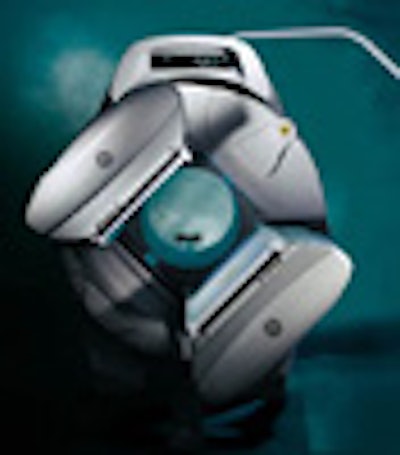
ST. LOUIS - One of the hottest trends in nuclear medicine is the development of hybrid imaging systems that combine nuclear medicine with anatomic imaging modalities like CT. At this week's Society of Nuclear Medicine meeting, GE Medical Systems displayed its approach to hybrid imaging with Hawkeye, an upgrade to the company's premium Millennium VG gamma camera.
Hawkeye combines a Millennium VG camera with an x-ray tube and digital detector that rotate around the patient as a nuclear medicine study is conducted, generating an image of anatomic structures. The anatomic data is then overlaid on the nuclear medicine image, creating a hybrid image that enables nuclear medicine physicians to view functional and anatomic information together.
GE believes that Hawkeye can help physicians find the location and extent of tumors quickly, which could be a boon in radiation therapy or surgical planning. Hawkeye has been installed at five beta sites around the world, with over 2,000 patients scanned to date. Clinicians using the system have changed patient management in 22% to 25% of cases, according to Beth Klein, general manager of global nuclear medicine and PET at GE.
GE first introduced Hawkeye as a work-in-progress at last year's SNM conference in Los Angeles. Since then, the Waukesha, WI, vendor has received 510(k) clearance for the upgrade. GE is offering Hawkeye as an option on new systems and as an upgrade to Millennium VG cameras in the field. It operates in both SPECT and PET modes, thanks to Millennium VG's support for coincidence detection imaging.
In addition to Hawkeye, GE is displaying a new gamma camera in its SNM booth, the Millennium MC. The system is a dedicated cardiac camera, with its dual detectors positioned in a fixed 90° angle, the most efficient configuration for cardiac studies.
Millennium MC will replace Optima and CardiaL in GE's product lineup of dedicated cardiac systems. Millennium MC uses newer detectors than the older systems, and can also be upgraded to a general-purpose camera by swapping detectors, Klein said. The system comes with the Emory Cardiac Toolbox suite of cardiac imaging software.
The third part of GE's SNM triad is eNTEGRA, a new workstation that combines nuclear medicine image processing software developed by GE and Elscint, the Israeli nuclear medicine company GE acquired in 1998. GE has taken the best software applications from both companies and ported them to the Windows NT platform, according to Klein. Users of GE's Genie workstation or Elscint's Xpert computer can migrate to eNTEGRA, and the system can also be used with the installed base of Starcam and Apex SP cameras. eNTEGRA also supports Internet connectivity.
GE's highlights in PET include a mobile PET camera first unveiled at the RSNA meeting, the company's miniTrace cyclotron, and a training program designed to help physicians learn about PET imaging. GE believes its mobile PET camera will prove particularly popular and constitute half of its PET system sales.
Thanks to increased reimbursement, the U.S. PET market is exploding this year: GE is projecting the PET market to grow 200% over the next four years, compared with 4% annual growth in the rest of the nuclear medicine market, Klein said.
By Brian Casey
AuntMinnie.com staff writer
June 7, 2000
Let AuntMinnie.com know what you think about this story.
Copyright © 2000 AuntMinnie.com
















